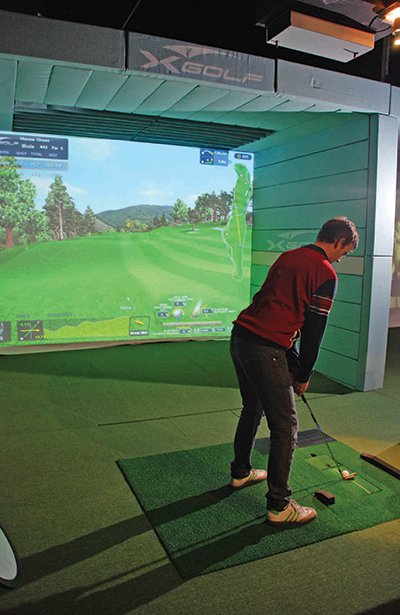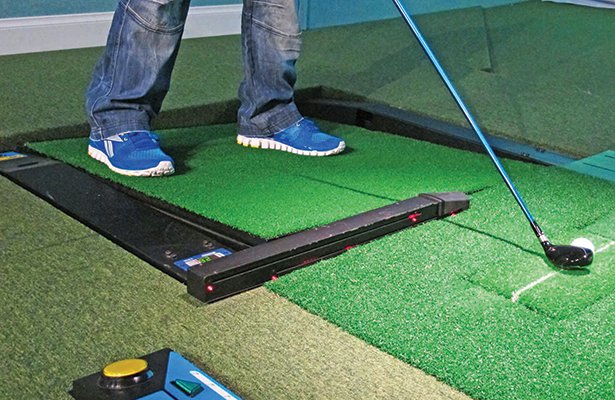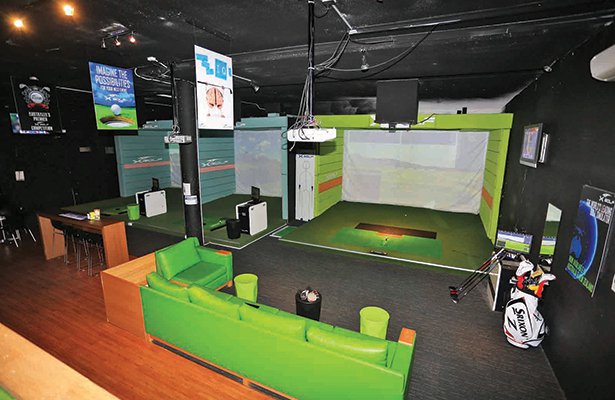Indoor-golf simulators might just be the way forward to growing the popularity of golf in Australia.
Ben Styles first considered setting up an indoor facility with golf simulators some 10 years ago. The PGA professional thought golf was itching for an exciting product that would cater for the increasingly time-sensitive golfer. At the time, indoor golf had been rather lesson-orientated as a training facility for the full swing. Indoor golf simulators (with the appeal of playing a world-class golf course) were seen as a bit of a novelty – because the hardware available in Australia hadn’t been designed to enable proper chipping and putting, nor was the software built for competition formats like Stableford and Ambrose. Comparisons to PlayStation games weren’t entirely unfair.
So Styles didn’t think the product was good enough to capture a discerning market like Australia where it’s relatively cheap to play golf outdoors, 12 months of the year, when golfers receive instant feedback on whether they’ve just hit a slice or a hook.
That all changed two years ago when he boarded a Singapore Airlines flight to Seoul for a meeting with RD-Tek, the maker of X-Golf simulators, which are found in more than 450 golf centres across Korea. Having trialled an X-Golf prototype in one of Melbourne’s largest golf retail stores, Styles, 29 years of age at the time, remembers chatting with his travelling companion, Michael Sheedy, 31, an independent franchise consultant, about the possibility of securing a deal that could change indoor golf in Australia. But they had little idea about what was about to transpire.
They spent the first evening at three different bars, drinking ‘shots’ with Song-hwan Choi, the reverential CEO of RD-Tek. An all-day board meeting followed where they made a more formal presentation. By the third day they were hitting golf balls on the simulators with ‘Mr Choi’, all the while being quizzed by a team of 30 R&D engineers and giving them feedback on how to improve their product. Suddenly, the nous of two young Aussies, combined with the high expectations of the Australian golfing public, were shaping what was already considered one of the leading simulators globally.
The pair returned home with the world’s first exclusive distributorship of X-Golf simulators. They had just negotiated a 10-year contract, free of rigorous key-performance indicators (KPIs) and the opportunity of a lifetime.
Today, there are three indoor centres with X-Golf simulators in suburban Melbourne (Malvern, Dandenong and the CBD) and installations in a number of private locations, including the prestigious Prima Pearl residential tower. Styles’ plan is to have simulators in every capital city by year’s end, while the long-term goal is to have 100 X-Golf facilities around Australia within 10 years.
The managing director of X-Golf Australasia has great belief in the potential impact of indoor golf. “It was a lot of hard work and a lot of long hours to get the model right. But we don’t see it as a financially beneficial model for us, which it is. We see it more as the opportunity of what X-Golf can do for golf in general – how it gets new people into golf and how it gives that 20 to 45-year-old an opportunity to play outside of their working life when most of their time is taken up by mortgages and kids.”

What features make X-Golf unique?
Styles could have opted for simulator hardware from aboutGolf or Full Swing Golf, which are respected names in the industry. But the reason he chose X-Golf was based on the overall package and the technology behind the hardware.
Every simulator and launch monitor has an algorithm to provide statistical feedback (including TrackMan, which follows the ball using radar technology). But X-Golf is the first simulator that measures every aspect of the golf swing – launch angle, ball speed, clubhead speed, club path, clubface orientation at impact, ball direction, spin rate and spin angle. It takes 50,000 measurements with every swing to accurately map the golf shot.
X-Golf is the only simulator that has an automatic ball return. The player doesn’t have to move after a shot, the ball just ‘pops’ out of the floor.
The height of the tee can be altered by millimetres and this enables a single person to play 18 holes in 40-50 minutes quite comfortably.
Another feature that makes X-Golf unique is its patented moving floor plate. The floor panel will adjust to mimic the lie on the golf course being played on the simulator. So the player won’t be hitting off a flat lie all the time – it can be an uphill, downhill or sidehill lie angle of up to 35 degrees.
Boredom isn’t an issue with a choice to play almost 100 top courses from around the world. The software from American design company E6Golf is compatible with any simulator, allowing a person to play St Andrews’ Old Course, Royal Troon, Pebble Beach, Spyglass Hill, Royal Melbourne, New South Wales, Cape Kidnappers or an extensive selection of courses from Korea and Japan. (See trugolf.com for course package list).
My first impression was that the footplate would be a bit of a gimmick. But once you start hitting shots from an incline (or decline), you realise it actually provides an element of authenticity to what is effectively, virtual golf.
The graphics are excellent and features like the ‘wind gauge’ add to the sense you’re playing real golf, such as when selecting a club based on how far you hit a ball in certain conditions.
Chipping and putting are the most difficult aspects to master. It requires hitting/stroking a ball into a screen five metres away, hence trying to judge the distance of, say, a 15-metre pitch is quite challenging at first.
But it’s obvious why people come again and again. “It’s so easy to play outside in Australia. So you need an experience that draws people back,” Styles says. “The accuracy is a huge positive, but then you’ve got the automatic tee, the speed of play and just the fun environment that X-Golf provides. That all-encompassing experience gets you addicted.”

Appeal to a younger demographic
The quest for fun explains the American phenomenon known as Topgolf, which is transforming the traditional driving range into an entertainment venue. Likened to tenpin bowling or darts, players hit a golf ball containing a personalised microchip to 11 targets ranging from 20 to 240 yards away. Each target has a reader that computes a score based on the accuracy and distance of the shot. In addition to 102 hitting bays on three storeys, Topgolf facilities have pool tables, HD televisions, a food and beverage service plus live bands and DJs. The 18-34 age demographic has been attracted to that version of virtual golf.
Likewise, the appeal of X-Golf is on display each week in the Melbourne suburb of Malvern where five simulators have been set up at The House Of Golf. About 20-30 young guys gather on Monday and Wednesday nights for match-play team competitions over 12 weeks with finals. Friday night is an individual competition interspersed with watching AFL, eating pizzas and drinking beer. Points accumulate throughout the 22-week season before concluding with an invitation-only Tour Championship.
A wide array of people is starting to discover X-Golf. Bucks Days are popular on weekends, while the centre has team-building events and private/group lessons. An encouraging development for golf participation is that three local independent schools – De La Salle College, Xavier College and Scotch College – have included X-Golf as part of the curriculum for students aged 10-18 years.
Classes of 20-30 schoolboys visit the Malvern site twice a day where they receive tuition from one of the resident PGA professionals. A standard lesson over a 45-minute period may focus on how to grip the club, followed by a putting or chipping contest and then the chance to play a few holes. “It’s the only class where the teachers actually struggle to get their kids out of it. They don’t want to leave,” Styles says.
In terms of attracting and keeping new people – especially juniors – to the sport, indoor golf might be the panacea the game needs. Helping children to make the transition into senior golf is the challenge facing MyGolf, Australia’s national junior introductory program that was designed for primary school children.
“You get to 11-12 years old and they say, ‘Just go down to your local golf course.’ And that’s where we lose them because it’s too hard,” Styles says. “They’re scared to walk into their local golf course. They might be yelled at because they’re socks aren’t pulled up or [shirts] aren’t tucked in. So we can break that down and make it easier for them. Not give them an excuse to stop.”
Anecdotally, many of today’s generation of kids grow up with an iPhone or an iPad at the ready. They’re watching TV and texting friends, while eating cereal for breakfast. The lure of X-Golf is that kids can have an interactive golf experience where they can play 18 holes in less than an hour. They enjoy indoor golf because it’s quick. It’s all computerised with automatic tees, so they don’t have to walk to their ball (or search for a lost ball). They can play on world-famous golf course like Pebble Beach (which has a green fee in excess of $700).
“It really appeals to that demographic,” Styles says. “Then what it does is create a golfer out of them. So for someone who was playing football, cricket or tennis, all of a sudden they’re a golfer. They’re buying a set of golf clubs. They’re going to a golf course to play a round of golf. And we’ve got a golfer for the next 50 years.”

Home entertainment
But it’s not just partygoers and schoolkids that are embracing X-Golf. Ben’s brother, Charles, has started private installations (including drawings and measurements) at homes in fashionable suburbs like South Yarra, Toorak and Brighton. Up to 10 more are planned over the next six months. However, it’s not cheap. The cost to purchase an X-Golf simulator starts from $30,000, rising to $110,000 for the top-of-the-range model. Three different versions can be customised according to a client’s budget. (For instance, the quality of a projector can vary from $1,000 to $10,000.)
Through word of mouth, the private installations have found a niche among those who can afford the price. “They are businessmen who don’t have enough time to play golf. They might be members at Royal Melbourne or Metro and they just want something where they can practise, play online, or get an online lesson.”
“So if someone is redeveloping their house, they know that golf simulators are an option. We design their room, do the fit-out and custom-build them all. They’re different heights, different sizes, left and right-handed, and whatever colour they want to fit into the décor of their house.”
Nor is the private-installation business confined to single dwellings. When building a new skyscraper, developers have tended to allocate space for an indoor pool and/or a gymnasium. However, they’re increasingly planning space for a golf simulator.
Multiplex included room for an X-Golf simulator as part of its recently completed Prima Pearl apartments on Melbourne’s Southbank. Virtual golf has proven to be popular among buyers and residents who can arrange a ‘tee-time’ through an online booking system.
Another X-Golf simulator is slated for what will be Melbourne’s tallest tower, Australia 108, where it will be located in the ‘Sky Rise Club’ on level 11 to complement a movie theatrette, a lap pool, sauna and barbeque area.
Little wonder Styles is optimistic: “Indoor golf is going to be a really big part of golf in Australia – and globally – in the next 10, 20 years until something else comes out.”



